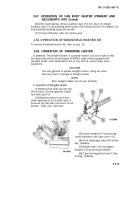TM-9-2320-361-10 - Page 283 of 392
TM 9-2320-361-10
3-6. GENERAL LUBRICATING INSTRUCTIONS UNDER
UNUSUAL CONDITIONS
a. Service Intervals.
Increase frequency of lubricating servce intervals when
operating under unusual conditions such as high or low temperatures, prolonged
high-speed driving, deep mud, and extended cross-county operations. Such
operations can destroy a lubricant’s protective qualities. More frequent lubricating
service intervals are necessary to maintain vehicle readiness when operating in
unusual conditions. During inactive periods, with adequate preservation, service
intervals can be extended.
b. Changing Lubricant Grade.
Lubricant grade used varies with weather
conditions. Refer to table 1-12 for lubricant grade changes for the following
temperature ranges:
(1)
+l5°F (-10°C) and above
(2)
+40°F to -15°F (+5°C to -25°C)
(3)
+40°F to -65°F (+5°C to -55°C)
(4)
Arctic conditions: Refer to FM 9-207
c. Maintaining Lubricant Levels.
Lubricant levels must be checked as specified in
LO 9-2320-209-12-1. Steps must be taken to replenish and maintain operating
levels.
3-7. LUBRICATION FOR CONTINUED OPERATION
BELOW 0•F (-17°C)
Refer to FM 9-207, Operation and Maintenance of Ordnance Materiel
in Cold
Weather (0°F to -65°F).
Section III. TROUBLESHOOTING
3-8. GENERAL
a. Scope.
The troubleshooting table contains instructions that will help the
operator identify and correct simple vehicle malfunctions during operations. The
table also helps the operator identify major mechanical difficulties that must be
referred to maintenance personnel. Major vehicle systems covered in this section
include:
Ž
Ž
Ž
Ž
Ž
Ž
Ž
Engine
Transmission
Transfer case
Front and rear axles
Air-hydraulic brake system
Wheels and tires
Steering
3-2
Change 2
Back to Top




















